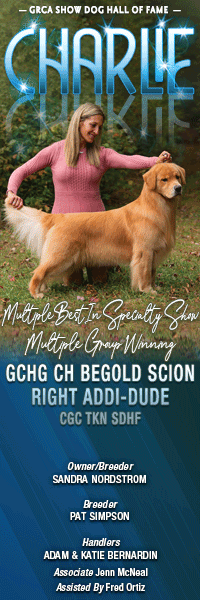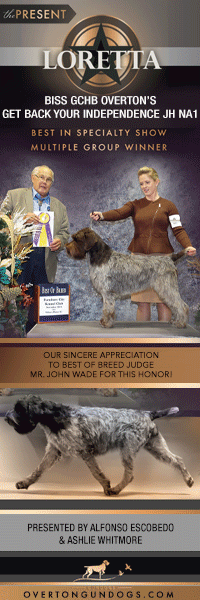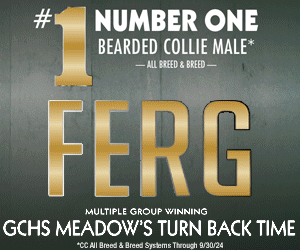One Man’s Trash Is Another Man’s Treasure

by Lisa Dubé Forman
Far too often we hear of heartbreaking stories where renowned dog fanciers, this includes breeders and judges, have passed on only to discover they had not bequeathed their prized, purebred dog collections, photographs, volumes of old books and other related treasures. Tragically these collections, in part or in their entirety are disposed of in the trash by family members, relatives, or non-dog friends assigned the task to clean out what had been left. Such egregious acts affect us all or maybe I should qualify ‘us’ as those fanciers who have spent the better part of their lives deeply involved, who truly care about the sport and our breed’s health and prosperity. It is painful to hear of our sport’s venerable past being thrown out because many executors had either no knowledge of value or, chiefly, they had no respect for these treasures. Indeed, the idiom is true, “One man’s trash is another man’s treasure.”
A friend and mentor of mine recounted an interesting story that shares common threads with other incidents. Sometime back my friend bumped into an old acquaintance, Mr. Freeman Claus, one of the great dog people of our sport’s history. Mr. Claus was part of the well-known husband and wife team of Redhill Norwegian Elkhounds based in Tustin, California. Their extensive experience spanned five decades of purebred dog life with both Freeman & Betty judging for AKC, Freeman being approved for Best in Show, Working Group and Junior Showmanship. Notably, both were honored by their breed’s parent club. Mr. Claus was inducted as an Honorary Lifetime Member of the Norwegian Elkhound Association of America (NEAA). Betty was the second recipient of the Ed Schlesinger Outstanding Service Award presented in honor of her work and efforts deemed to have been of outstanding quality and benefit to the Association and/or the Norwegian Elkhound breed. Mr. & Mrs. Claus were also charter members of the Shoreline Dog Fanciers Kennel Club in Orange County, California. So, over their five decades they collected vast memorabilia, photographs, dog prints and the like.
After my friend and the elderly Mr. Claus went their separate ways, Betty having since passed on, my friend kept thinking about the serendipitous encounter. She pondered and debated contacting Mr. Claus to record his revered history, if it had not been done so already, and to inquire after the fate of his sizable collection of old purebred dog photographs and dog prints. As fate would have it, she did not make contact. Four years later in March of 2012, Mr. Claus passed away and, as it turned out, my friend was performing research for her ongoing dog magazine article about our sport’s highly acclaimed late, great dog fanciers. As Mr. Claus had recently passed, she reached out to Mr. Claus’s son and was informed that much of the dog material that Freeman and Betty collected over the decades — hundreds and hundreds of old dog photographs and other archival material–was apparently thrown out. How sad this news must have been for my friend, especially bringing to mind the cruel twist of fate with her previous deliberation on contacting the elderly man regarding his collection when the opportunity presented itself. The family’s decision to discard the memorabilia was a loss for us all.
Two decades ago I had the great pleasure of striking up a friendship with a renowned sporting gentleman, published author, CKC Judge and past breeder of Great Danes, Mr. Robert Heal. For those of you who are not familiar, Mr. Heal is the author of two nonfiction books He Whacked the Bloody Lot and The Danes of Send Manor along with his new fictional canine novels titled, The Bloodhound Mystery Series. The former book He Whacked the Bloody Lot is based on Bob’s longtime friendship with the infamous Mr. Bill Siggers of England. Mr. Siggers was an extremely colorful figure in England’s purebred dog world who began his career in the early to mid-1900s by managing Mr. & Mrs. J.V. Rank’s grand Ouborough Irish Wolfhound and Great Dane Kennels. To their credit, Siggers and the Ranks were tremendously successful with Siggers piloting the Rank’s Great Dane, Ch Elch Edler of Ouborough to Crufts 1953 Best in Show. Mr. & Mrs. Heal became very close friends with Mr. Siggers and eventually they became the recipient and guardians of a wonderful, valuable collection of early to mid-1900s memorabilia with countless dog photographs that were simply stunning. This collection was incredible, the photographs depicting not only early 1900s Irish Wolfhounds on the Rank’s Surrey, England grandiose estate but an equally impressive Great Dane collection. Several years ago when speaking with Bob, I inquired after his collection and I was greatly disappointed to hear that he had parted with the bulk of his acquisition by selling it to a collector. First, the collection is assumably in safe hands. Furthermore, it was his to do with as he wished. However, I was deeply disappointed because I always adored the collection. I would have loved an opportunity to have purchased some or all of it. Another opportunity lost because the difference between myself and many collectors are motivations and intentions. I would have made this extraordinary collection available for the world to review and admire, mostly through the Internet. Call me an old soul and or old fashioned, but my innocent intentions are authentic. Glorious collections such as this one belong in the light of day and not shuttered away in someone’s private home or vault where but a few or even possibly only one person can enjoy it. Particularly, this collection depicted the Wolfhounds and Great Danes in their early splendor unaffected by today’s restyling of their shape, size, bone and temperament. As far as I can tell, this collection, sold approximately three years past, has not been made available for the world to feast their eyes upon, to study and as a result, would sorely educate. Another major loss for us all.
In my research for this article I spoke with a dynamic, purebred dog enthusiast and AKC Judge, Noreen Gonce Cartwright. This sportswoman’s dedication, enthusiasm, and self-determined drive is admirable. She is the driving force behind the creation of the Canine Research Collection at the Oregon State University and her story is exemplary. Mrs. Cartwright and her late husband, Fernandez (Wes) Cartwright owned a valuable dog memorabilia collection, including 2500 volumes. On or about 2000, Noreen Cartwright began to investigate options to safeguard this wonderful collection. She began looking around for possible depositories for such valuable, archival material. She was disappointed, unable to find any suitable museum or library on the West Coast of the United States to begin a repository for not only hers but also other fanciers collections or historical records. Mrs. Cartwright desired to have an alternative to the East Coast’s AKC New York Library, in which the latter librarian since has been dismissed. While discussing her desires and predicament, two dog fanciers who were Professors at the Oregon State University suggested that she approach the University. Oregon State University with its College of Veterinary Medicine along with the Lois Bates Acheson Veterinary Teaching Hospital seemed like a perfect fit. The curator of the University’s library which has a number of special collections, notably for two-time Nobel Prize recipient Linus Carl Pauling, generously made available 750 feet of shelf space (linear feet) for Mrs. Cartwright’s generous donation and ambitious project. Henceforth, the beginnings of Oregon State University’s (OSU) Canine Research Collection with material dating from 1801-2010. The collection, with over 300 boxes and 1900 books, houses old purebred dog photographs, pedigrees, personal correspondence, volumes, all of which are inventoried and sleeved. The special collection library is staffed and the research collection is outlined on the OSU website, found at http://osulibrary.oregonstate.edu/specialcollections/coll/index.html. OSU proudly describes their 1801-2010 Canine Research Collection,“The collection provides opportunities for research on the history of canines in art and literature, the development of specific dog breeds, current issues in canine genetics, developments in training methods and the history of major dog show competitions, among many other related topics.”
Wonderful as this is, it becomes even more so because Mrs. Cartwright is accepting other donations from like-minded individuals. She has been contacted by many purebred dog fanciers who judiciously have been arranging the well-being of their prized possessions. However, space long ago became a premium as Noreen has filled three-quarters of the available space. Mrs. Cartwright informed me that space limitations required that she narrow the focus of the collection as the volume of material she was offered, in just a few years, would have filled a couple thousand shelf feet! In her effort to prioritize, Mrs. Cartwright states, “It came down to asking what material would be most used or have the widest base of information. If you were new to the dog game or were researching a breed or wanted to know who the ‘greats’ were, or were doing pedigree research, what type of material would be most helpful? Books are a concentration of breed information. So are scrapbooks, and we have them on kennels and dogs filled with photos and pedigrees. There are teaching scrapbooks from C. Bede Maxwell complete with annotated photographs and notebooks from Irene Schlintz’s columns on top winning dogs.”
Mrs. Cartwright is the point person and should be contacted directly for additional information. Ideal contributions to Oregon State University’s Canine Research Collection can range from old, identified photographs, books and journals, vintage pedigrees, and older personal correspondence. These items are researchable as well as magazines, although Noreen’s limitations require her to remove the articles of interest from later magazine issues for archiving to conserve space. Unfortunately catalogs are not acceptable because show wins were and are researchable through the AKC. Lastly, because this is a library and not a museum, the archives cannot accept paintings, ribbons, trophies, statues, etchings or carvings. However, in our conversation we bandied about several ideas for other possible repositories of such valuable and treasured items. I also believe a special movie repository is necessary for old 8 mm films (along with our newer formats) of purebred dog sporting events, the dogs themselves, historic kennels and the late, past giants of our sport, if any of the latter two exist. This special movie collection could include innumerable old films and recordings of our breed’s past and perhaps in the future, when time and funding is available, they can be converted to DVD format for preservation. I will keep everyone informed of other prospects to house these potentially enormous-sized collections that may arise. Mrs. Noreen Cartwright can be contacted at shewatches@msn.com.
As many are already familiar, the American Kennel Club Museum of the Dog in Queeny Park, St. Louis, Missouri is an option that fanciers can explore for donations. This option, however, may be more exclusive as the museum has exacting standards. The museum will consider gifts given by foundations, private individuals and bequests which include donations of paintings, prints, drawings, photographs, bronzes, porcelain, and decorative arts as well as books and archival materials of interest. Donations must meet certain criteria which appears on their website under Gift Policy at http://www.museumofthedog.org/gift_policy.html and the museum has the following disclosure, “All works of art offered to the American Kennel Club Museum of the Dog must be considered by an accessions committee, if applicable a conservation authority, and finally the Board of Directors.”
It is reported that to access both this museum and the AKC Library in New York City, one must schedule an appointment. If this is true, the accessibility factor has an impact on research and virtually is no better than having a collection in private hands locked away in some vault. I also suspect that a majority of the collections in private hands may not meet such exacting standards described above as many breeders, the backbone of our sport, are not wealthy benefactors with fabulous, rare oils or sculptures. Instead, their collections compose the generational real life history of our breeds in various formats and are in most cases more valuable to dog fanciers than an oil painting by a renowned artist. Hence the need for additional repositories to serve as a solution to the heartbreaking problem of dog fanciers’ extraordinary collections being donated to the garbage man.
Noreen Cartwright’s story has a happy ending with the steps she took to ensure the well-being of her prized collection. Some people are performing their due diligence, well in advance, to plan for the welfare of their cherished collections. Sadly though, there are many people who simply have not done so. There are accounts of breeders or celebrated all-inclusive ‘dog lovers’ who have amassed an abundance of wonderful possessions related to purebred dogs or certain breeds and these items we consider riches were discarded after their death. Throughout the years and after much observation and even some personal experience, I have been drawn to the following conclusion. Many ‘non-dog’ people believe the aforementioned printed material, photos and the like, at the risk of sounding crass, are crap.
My husband enjoys the History Channel television series called “American Pickers.” If you have watched this program you will already know that these two gentlemen are junk aficionados and the dirtiest and most unwelcoming junkyard, the creepiest dilapidated building, all may be goldmines for these Pickers. These Pickers make their money foraging through these places buying memorabilia, objets d’art, oil cans, old toys, gasoline signs and pumps, photographs, prints, old rusted bicycles, their frames and parts, old car and motorcycle parts, on and on. Their company is called “Antique Archeology” and there is one sure thing I learned from this show. It seems almost everything has value to another person. The most mundane, rustiest, scarred item can be appraised based on emotional or market value.
Why then are dog collections not respected, why are most discarded in such a cavalier manner by executors, family members or friends of the deceased? Almost everyone has an ardent pastime; in the dog world we are especially committed because the recipient of our attention is not an inanimate object but a warm, loving animal. Our favorite pastime is no less meaningful than golf, tennis or even horse show jumping which other members of society partake in. It is difficult to understand but it seems that some ‘non-doggy’ friends and family on the peripheral are dismissive of and belittle the sport. They have no appreciation for the memorabilia, some with the jaded attitude why anyone would care about all these ‘stupid’ photos, books and journals on dogs. I find it very upsetting when I learn of, observe or even experience the indifferent, sometimes disgusted attitudes and actions of family ‘non-dog’ members towards a relative’s lifelong dedication and passionate pursuit of purebred dogs. Some family members are scornful of the blood, sweat and tears invested in the dogs. Others persecute because of the expense and the sacrifices that such dog person has made over the course of their lives. Many ‘non-dog’ people have excessively critical points of view believing dog people waste their lives and “all that money” spent on the dogs instead of perhaps spending it on what they perceive as sensible, such as travel, expensive homes and furnishings, or on more acceptable social class sports such as golf. There are children who hold a long-lasting resentment towards “the dogs” and the sport because they perceived the dogs came first while they were growing up.
Admittedly, we all know there are dog fanciers who have a tendency for or have become preoccupied with dogs to a troubling, intrusive extent. I am not speaking about hoarders who are overrun with dogs, their property in dilapidated condition with dogs kept in deplorable conditions. I am describing dog fanciers who on the façade appear well-tended, unremarkable, but whose lives are immersed in and revolving around the dog world. They live, eat and breathe dogs. They characterize their life based on their acclaim, their wins and accomplishments in the show ring. They spend almost all of their free time on social media outlets discussing, arguing topics related to dog clubs exhibiting, breeding and judging dogs–they are engrossed in gossip chat lists. Many regularly spend holidays attending dog shows leaving their families or significant others behind. I recall reading an article in the past by Peter Belmont who discussed in a very straightforward manner the necessity for keeping one’s perspective and may be of value for some to review.
Nonetheless, putting aside these people with obsessive-compulsive behavior, there are healthy, normal dog people involved in the sport who regulate themselves. I fanatically try to maintain a healthy, well-rounded perspective in my life with my time spent on a number of various interests. I strive for objectivity and balance when selecting the number of dogs shows I attend, I maintain a limited number of hounds, and by most all measures, I breed infrequently. I do not breed every bitch and when I do breed, the bitch will only have one litter. In the past I have refrained from breeding bitches when there was a surfeit of puppies on the ground from other breeders. My husband and I lead a full life with extended visits to our families enjoying non-related dog activities and when my husband and I officially vacation–we try to do so annually–there are no diversions such as visiting kennels or, while in a foreign country, attending dog shows. If I have a long-distance judging assignment in an appealing location, my husband and I typically travel together where we extend our stay and sightsee the region. I pride myself on how I have tried to carefully balance my life while still dedicating the time and focus necessary to excel in our sport. In spite of all my strenuous efforts, we too have experienced sporadic, negative comments and judgements from our own families. Upsetting comments such as “Get rid of the #%*! dogs,” “Your life would be so much easier if you did not have those damn dogs” and so forth. Even though these comments have been sparse, I am astute enough to realize this is a summation of their opinions and appraisal about my life’s passion, though they rarely express it.
I know many dog friends who have experienced decades worth of similar and much worse criticism from their own families and I have seen it tear apart marriages. It is sad but all too true that many of our family members, friends or executors not involved in our sport, secretly or not, are inclined to pass judgement on our enduring love affair. Simultaneously, they may view dog people’s acquisitions of photographs, books, magazines, journals, articles, prints, ribbons, trophies, and etchings as rubbish, worthless. In the simplest terms, accumulated crap. This is why we hear stories about those executors, children or friends, not having detailed instructions throwing out such precious collections. We hear of families giving members of dog breed clubs 24 hours to remove what they can from the deceased’s home before they come in and haul what is left to the dump. I know of a situation where family members, despite an official Last Will & Testament, acted against the deceased’s wishes on more than one stipulation in the Will. Suffice to say the least deplorable of the family’s reprehensible acts was disposing of the collections of books, journals, old magazines, prints, and photographs.
What to do? We all must accept our mortality and be proactive for the welfare and continuity of our collections. We must prepare well in advance and at the very least, by way of a written instrument, that all such catalogued possessions, however meager or bountiful, be entrusted to a party or parties that will ensure their survival. Moreover, I suggest that our elderly dog fanciers and those who are suffering with serious health problems consider donating their collections in advance. In doing so, this protects against the possibility that one’s stated or written wishes might not be carried out after one is gone as there is precedent. I admit that there may be great reluctance to donate the long accumulated collections in advance. However, consider the possibility that these could be disbanded, neglected or forsaken. I have to ask if those elderly dog fanciers with their impressive archival collections, who have long since retired, regularly enjoy them or does the material sit, untouched, accumulating dust on a shelf or stowed away in a box in the back of a closet? Even those with the best of intentions can let a collection sit untouched for years as they are simply too busy to set aside time to enjoy the riches their collections contain. There are many breed parent clubs who have a historian or archivist who collects the breed data, records, and perhaps much more extensive material. Some of these individuals maintain the material and collections in their private homes, some house the information in storage units. This is good for a collection point but what use is it sitting in a store room without accessibility? Lastly, consider there are many dog fanciers who prefer not to donate their collections to the parent breed club. In my opinion, the model depository for all our collections is a University. More specifically, one or more well-funded universities who have a connection with canines with academic colleges of veterinary medicine. Why well-funded? In these economic times we want to ensure such donated collections continuity and not have them at risk in future budgetary cuts. Also, many universities typically have graduate students who categorize, itemize, sleeve and attend to the special collections in their libraries. This eliminates the need for a bricks and mortar building that parent breed clubs may have to secure to store all their archival material.
My hope is that most of our riches will be available for all the world to research even if they are 3000 miles distant, though I know this may be a tall order. Meanwhile and until archives such as the Oregon State University can be digitalized, if ever, those collections in safekeeping are available for physical research. The operative word is that they are safe and they will serve as valuable historical records for motivated individuals, now and in the future, to study.
If you feel you have ideas for new repositories to house such dog collections please feel free to contact me at lisa@lisadubeforman.com.
Short URL: https://caninechronicle.com/?p=3023
Comments are closed











